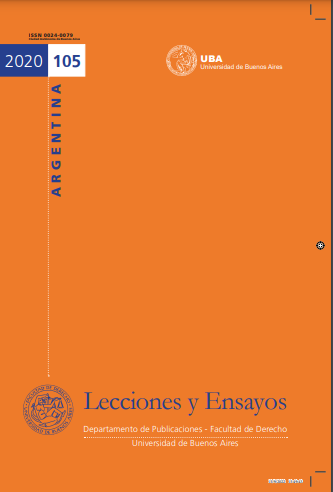PRINCIPIOS GENERALES DEL DERECHO Y EL DERECHO ISLÁMICO
Keywords:
islamic law, general principles of law, international court of justice, representivity of Islamic law, sources of international public lawAbstract
There are jurists that sustain that the general principles of law, sources of International Law, are those that are recognized in all legal systems, determined by the comparative law method. Nevertheless, some authors and jurisprudence have shown that in practice the judges apply the law that they know, and
that most of the members of the International Court of Justice have an education in the occidental legal system.
This situation has caused some States, including Islamic States, not to feel represented by International Law. There is a tendency between States with a majoritarian Muslim population to establish Islamic Constitutions, but also to play a more important role in the international field and to settle international relations with non-Muslim States. These actors have manifested themselves against the lack of legitimation of International Law, which constitutes a problem because international conflicts among and with these States should be resolved according to the law. Consequently, it is really important the joint lecture of the article 38.1.c) and 9 of the Statute that establishes that the Court should be composed in a way that represents all nations, or at least the principal legal systems.
The project’s hypothesis is that the International Court of Justice doesn’t take into account Islamic Law when it applies general principles of law and this situation has a correlation with the nationality and education of the judges.
Downloads
References
ASQUITH, Herbert H., “Petroleum Development Ltd. v. The Ruler of Abu Dhabi”, Laudo Final, 1951, ILR 144.
BADAR, Mohamed E., “Islamic law (shari’a) and the jurisdiction of the international criminal court”, en Leiden Journal of International Law, 2011, Vol. 24 (2), pp. 411-434.
BIANCHI, Andrea, International Law Theories, Oxford University Press, 2016, Oxford.
BUERHAN, Saiti & ABDULLAH, Adam, “The Legal Maxims of Islamic Law (Excluding Five Leading Legal Maxims) and Their Application in Islamic Finance”, en JKAU: Islamic Economy, 2016, Vol. 29, pp. 139-151.
BUIS, Emiliano, “El derecho internacional público: concepto, características y evolución histórica”, en GONZÁLEZ NAPOLITANO, Silvina (coord.), Lecciones de Derecho Internacional Público, Errepar, 2015, Buenos Aires, pp. 1-21.
Consejo de Derecho Humanos, A/HRC/17/31, “Informe del Representante Especial del Secretario General para la Cuestión de los Derechos Humanos y las Empresas Transnacionales y Otras Empresas, John Ruggie”, 21/03/2011.
Corte Internacional de Justicia, “Case concerning Gabčíkovo-Nagymaros Project”, “Hungary v. Slovakia”, Judgment, 25/09/1997, ICJ Reports 1997.
——, “Case concerning Maritime Delimitation in the Area between Greenland and Jan Mayen”, “Denmark v. Norway”, Judgment, 14/06/1993, ICJ Reports 1993.
——, “Case concerning Pulp Mills on The River Uruguay”, “Argentina v. Uruguay”, Judgment, 20/04/2010, ICJ Reports 2010.
——, “Case concerning United States Diplomatic and Consular Staff in Tehran”, “United States of America v. Iran”, Judgment, 24/05/1980, ICJ Reports 1980.
——, “North Sea Continental Shelf Cases”, “Federal Republic of Germany v. Denmark”, Judgment, 20/02/1969, ICJ Reports 1969.
Estatuto de la Corte Internacional de Justicia, 24/10/1945, San Francisco, Estados Unidos.
GUTTERIDGE, Harold C., “The Meaning and Scope of Article 38 (1) (c) of the Statute of the International Court of Justice”, en Transactions of the Grotius Society, 1952, Vol. 38, pp. 125-134.
International Law Association, “Conference Report 2010”, en Islamic Law & International Law Committee, 2010, The Hague, URL https://www.ila-hq.org/index.php/committees.
JAHEL, Selim, “Les principes généraux du droit dans les systèmes arabo-musul-mans au regard de la technique juridique contemporaine”, en Revue internationale de droit comparé, 2003, Vol. 55, Nº 1, pp. 105-122.
JALET, Frances T., “The quest for the general principles of law recognized by civilized nations a study”, en UCLA Law Review, 1963, Vol. 10 (5), pp. 1041-1086.
KHADDURI, Majid, “Islam and the modern law of nations”, en American Journal of International Law, 1956, Vol. 50 (2), pp. 358-372.
KHALIQ, Urfan, “The International Court of Justice and its Use of Islam: Between a Rock and a Hard Place?”, en Oxford Journal of Law and Religion, 2013, Vol 2, Nº 1, pp. 98-108.
LOMBARDI, Clark B., “Islamic Law in the Jurisprudence of the International Court of Justice: An Analysis”, en Chicago Journal of International Law, 2007, Vol. 8, Nº 1, pp. 85-118.
——, “Designing Islamic constitutions: Past trends and options for a democratic future”, en International Journal of Constitutional Law, 2013, Vol. 11, p. 620.
MOHAMMED, Khaleel, “The Islamic Law Maxims”, en Islamic Research Institute, 2005, Vol. 44, N°2, pp. 191-207, URL http://www.jstor.org/stable/20838961 consultado 27/01/2021.
MUNIR, Muhammad, “Islamic International Law (Siyar): An Introduction”, en Hamdard Islamicus, 2012, Vol. XXXX, Nº 4, pp. 37-60.
PALLARES BOSA, Jorge, “El derecho internacional desde la perspectiva del Islam”, en Revista Jurídica Mario Alario D’Filippo, 2011, pp. 94-104.
ROBERTS, Anthea, Is International Law International?, Oxford University Press, 2017, Oxford.
WESTBROOK, David A., “Islamic international law and public international law: Separate expressions of world order”, en Virginia Journal of International Law, 1993, Vol. 33, N° 4, pp. 819-898.
Published
How to Cite
Issue
Section
License

This work is licensed under a Creative Commons Attribution-NonCommercial 4.0 International License.











